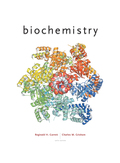
Concept explainers
Answers to all problems are at the end of this book. Detailed solutions are available in the Student Solutions Manual, Study Guide, and Problems Book.
Calculating the Molecular Weight and Subunit Organization of a Protein From Its Metal Content The element molybdenum {atomic weight 95.95) constitutes 0.0K if the weight of nitrate reductase. If the molecular weight of nitrate reductase is 240,000, what is its likely quaternary structure"?
Interpretation:
The quaternary structure of the nitrate reductase needs to be determined based on its molecular weight and percentage of element molybdenum with atomic weight 95.95 present in it.
Concept introduction:
Nitrate reductase’s quaternary structure can be determined by calculating molecular weight of the molybdenum and its number of moles in nitrate reductase.
From the number of moles of a species and its molar mass, mass can be calculated as follows:
Here, n is number of moles and M is molar mass.
Answer to Problem 1P
Molecular weight of molybdenum=192 g/mol
Number of moles of molybdenum= 2.00 mol
Nitrate reductase’s quaternary structure consists of two peptide chain and each peptide has one mol of molybdenum. Thus, it is a dimer.
Explanation of Solution
The Nitrate reductase’s quaternary structure can be determined by calculating number of moles of the molybdenum in a nitrate reductase where one mol of molybdenum is constituted by each peptide.
Molecular weight of molybdenum = nitrate reductase’s molecular weight × molybdenum percentage in nitrate reductase
Therefore,
Molecular weight of molybdenum is used to determine the number of moles of molybdenum in nitrate reductase as follows:
Here, m is molecular weight of molybdenum present in nitrate reductase and M is atomic weight or molar mass of the molybdenum.
Putting the values,
Thus, the number of moles of molybdenum in nitrate reductase is 2.00 mol.
As we know that, one mol of molybdenum is constituted by each peptide. Therefore, nitrate reductase is dimer which is made up of two equivalent peptide chains. And each peptide chain consists of one mole of the molybdenum.
Molecular weight of molybdenum is calculated by using molecular weight of nitrate reductase and molybdenum percentage. The value of molecular weight of molybdenum is needed in finding the number of moles of molybdenum in nitrate reductase. From these calculations, it is determined that the quaternary structure of nitrate reductase constitutes two peptide chains and each chain has one mol of molybdenum.
Want to see more full solutions like this?
Chapter 5 Solutions
EBK BIOCHEMISTRY
- The following data were recorded for the enzyme catalyzed conversion of S -> P. Question: Estimate the Vmax and Km. What would be the rate at 2.5 and 5.0 x 10-5 M [S] ?arrow_forwardPlease helparrow_forwardThe following data were recorded for the enzyme catalyzed conversion of S -> P Question: what would the rate be at 5.0 x 10-5 M [S] and the enzyme concentration was doubled? Also, the rate given in the table is from product accumulation after 10 minuets of reaction time. Verify these rates represent a true initial rate (less than 5% turnover). Please helparrow_forward
- The following data was obtained on isocitrate lyase from an algal species. Identify the reaction catalyzed by this enzyme, deduce the KM and Vmax , and determine the nature of the inhibition by oxaloacetate. Please helparrow_forwardIn the table below, there are sketches of four crystals made of positively-charged cations and negatively-charged anions. Rank these crystals in decreasing order of stability (or equivalently increasing order of energy). That is, select "1" below the most stable (lowest energy) crystal. Select "2" below the next most stable (next lowest energy) crystal, and so forth. A B 鹽 (Choose one) +2 C +2 +2 (Choose one) D 鹽雞 (Choose one) (Choose one)arrow_forward1. Draw the structures for the fats A. 16:2: w-3 and B. 18:3:49,12,15 2. Name each of the molecules below (image attached)arrow_forward
- draw the structures for the fats A. 16:2:w-3 B 18:3:9,12,15arrow_forward1. Below is a template strand of DNA. Show the mRNA and protein that would result. label the ends of the molecules ( refer to attached image)arrow_forwardAttach the followina labels to the diagram below: helicase, single stranded binding proteins, lagging strand, leading strand, DNA polymerase, primase, 5' ends (3), 3' ends (3) (image attached)arrow_forward
- 1. How much energy in terms of ATP can be obtained from tristearin (stearate is 18:0) Show steps pleasearrow_forwardMultiple choice urgent!!arrow_forward1. Write the transamination reaction for alanine. Indicate what happens next to each of the molecules in the reaction, and under what conditions it happens. 2.arrow_forward
 BiochemistryBiochemistryISBN:9781305577206Author:Reginald H. Garrett, Charles M. GrishamPublisher:Cengage Learning
BiochemistryBiochemistryISBN:9781305577206Author:Reginald H. Garrett, Charles M. GrishamPublisher:Cengage Learning
